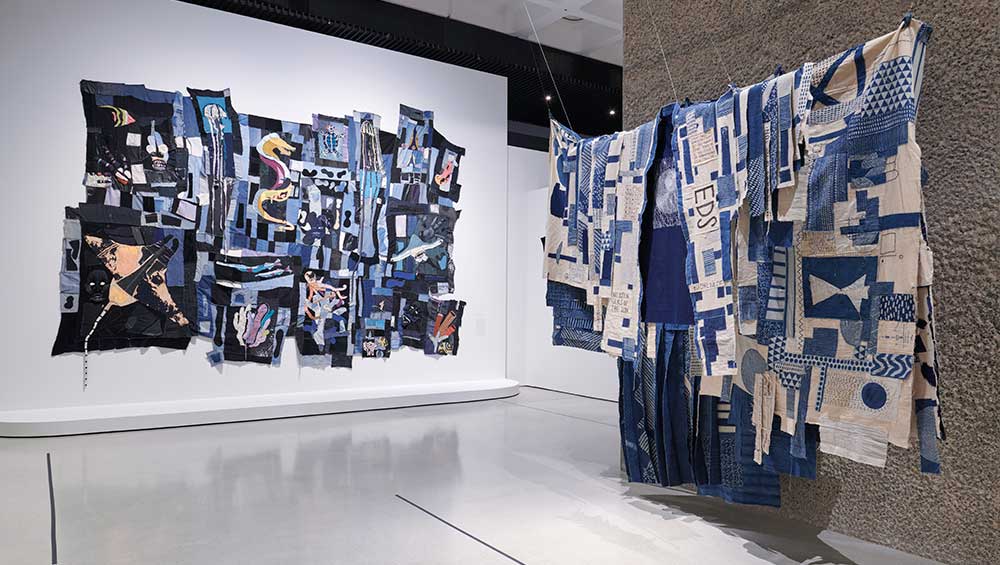
Unravel: The Power and Politics of Textiles in Art, installation view, Barbican Art Gallery. © Jo Underhill, Barbican Art Gallery.
Barbican, London
13 February – 26 May 2024
by BETH WILLIAMSON
From birth to death, textiles are an intricate part of our lives. They provide clothing, protection, warmth and comfort. The question at the heart of this exhibition is one all the artists here have grappled with in different ways. What they have in common is that they have all engaged with the question of how textiles can be used as a tool for resistance, to reshape and reimagine the world around us. The idea of the power and politics of textiles in art is explicit in the exhibition’s title and is borne out in every artwork displayed as part of this formidable show. Picking up on art and textile’s many histories and metaphors, the exhibition structures the work of 50 artists and about 100 works across six themes.
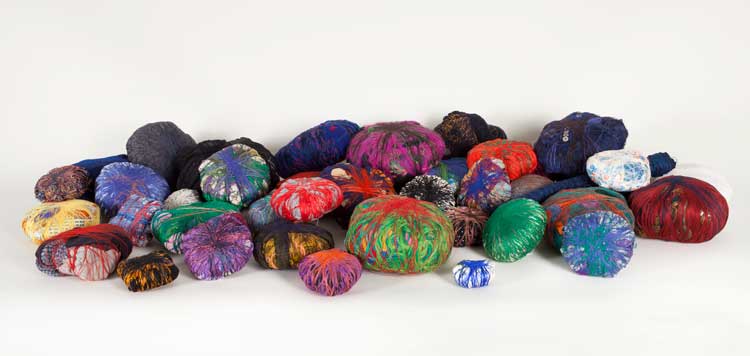
Sheila Hicks, Family Treasures, 1993. © Sheila Hicks, ADAGP, Paris and DACS, London 2023, courtesy Stedelijk Museum Amsterdam.
The exhibition opens with “Subversive Stitch”, firmly anchoring itself in art historian Rozsika Parker’s 1984 book of the same name. Parker’s motivation for the book was to examine why textiles were so often dismissed as “women’s work” and how, despite this, women have used textiles for subversion and resistance. This exhibition expands on Parker’s ideas by including multiple generations and genders of artists. In the 1980s, the Egyptian artist Ghada Amar (b1963) was not permitted to enrol in a painting class at art school because she was a woman. In a direct challenge to this, she uses embroidery with its feminine associations to make a work that gestures to the traditionally masculine act of painting. The work of Lebanese artist Mounira Al Solh (b1978) combines ink and embroidery in Paper Speakers (2020-21), made in response to protests that took place in Lebanon in 2015 amid growing economic crisis and leading to revolution in 2019.
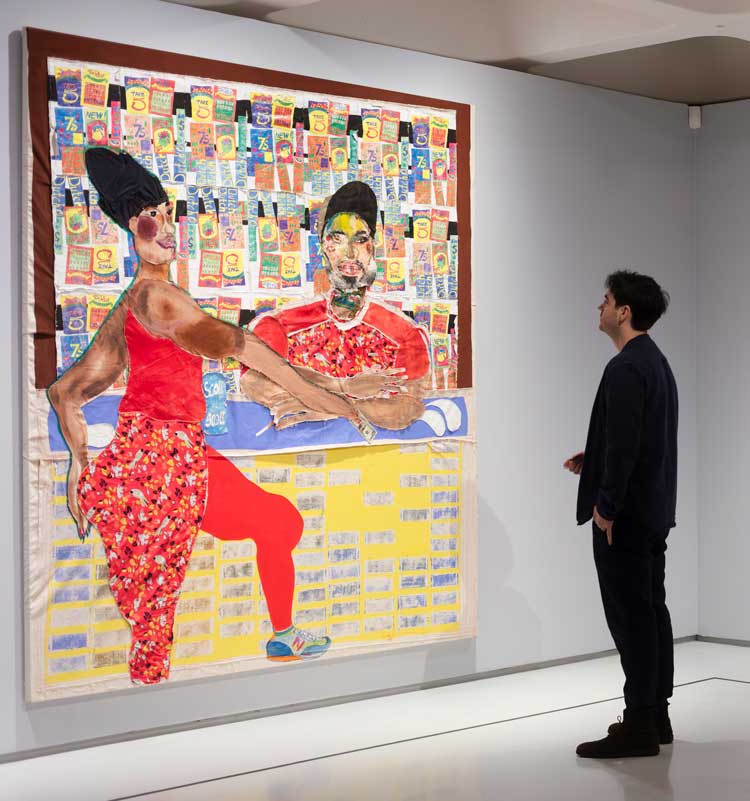
Tschabalala Self, Koco at the Bodega, 2017. Installation view, Unravel: The Power and Politics of Textiles in Art, Barbican Art Gallery 13 Feb – 26 May 2024 © Jemima Yong / Barbican Art Gallery
Moving into the “Fabric of Everyday Life”, the exhibition picks up on how embedded fabric is in our everyday lives, the good and the bad, the pleasurable and the painful. Family Treasures (1993) is an intensely personal work by Sheila Hicks (b1934). The artist asked friends and family to donate their most treasured item of clothing to her. Each item was tightly wrapped in colourful yarn and thread as a reminder of what we hold dear. The American artist Tschabalala Self (b1990) interrogates “how a body is consumed, how a body is experienced and how a body is inhabited”. In Koco at the Bodega (2017), she interrogates the experience of living in a black woman’s body and celebrates the bodega as a site of community.
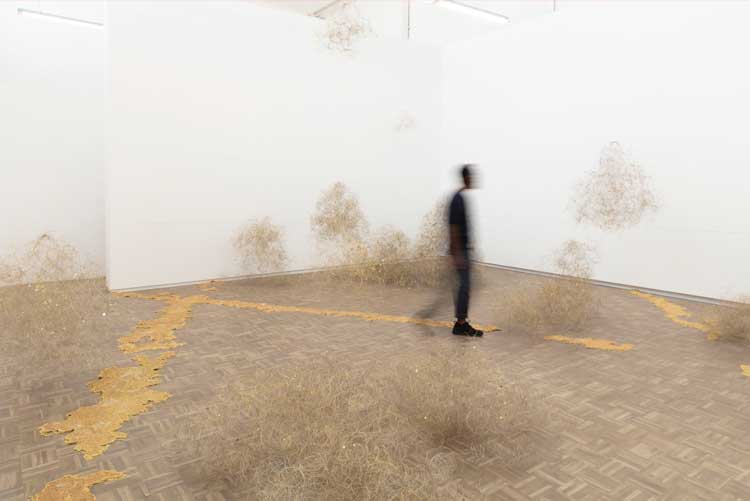
Igshaan Adams, Gebedswolke (Prayer Clouds), 2021–23. © Igshaan Adams, courtesy the artist and blank projects, Cape Town.
The “Borderlands” of experience are the subject of the next section of this exhibition. It takes its idea from the American scholar Gloria E Anzaldúa, who described the borderland as a “vague and undetermined place created by the emotional residue of an unnatural boundary”. The gossamer weave of work by South African artist Igshaan Adams (b1982) is poignant, atmospheric and simply beautiful, despite the complex and painful stories it tells of race, religion and sexuality. Work by the Sri Lankan-born artist T Vinoja (b1991) is very different from that by Adams. In Bunker & Border and The Day, both from 2021, Vinoja uses stitching to explore the effect of the decades-long Sri Lankan civil war (1983 to 2009), especially in terms of loss of life, disability and displacement. The cartographic works of the Filipino artist Cian Dayrit (b1989) are tools for investigation into the imperial power and control they help to impose. In Valley of Dispossession (2021), the artist shows how practices of extraction have destroyed land and communities in the Central Luzon region of the Philippines.
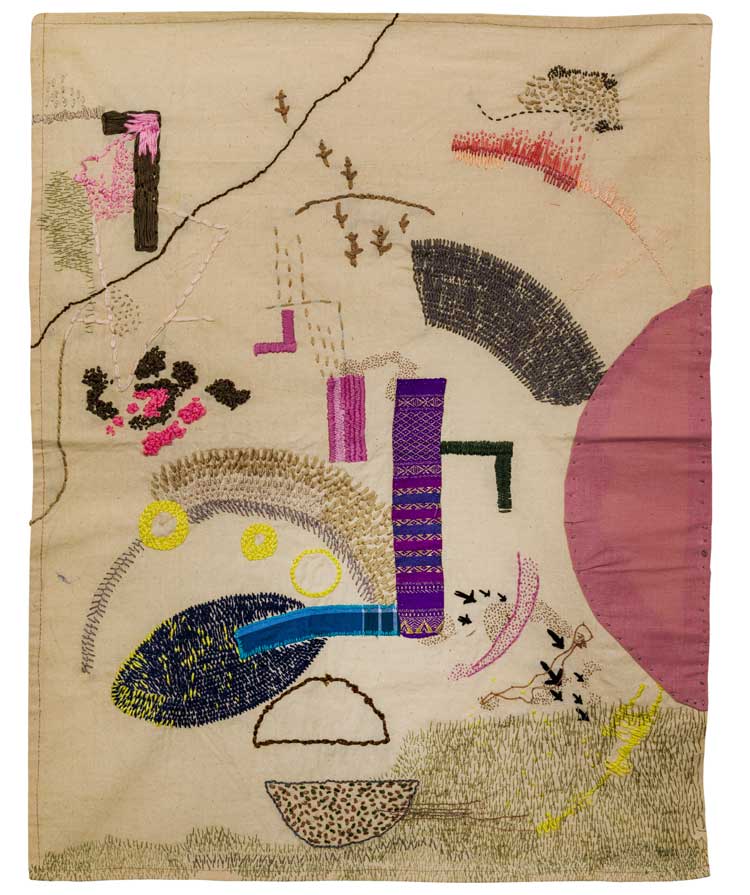
T. Vinoja, Bunker & border, 2021. Courtesy the artist and Experimenter.
Under the umbrella of the exhibition’s fourth theme, “Bearing Witness”, a number of artists do just that, using textiles to document or protest against political violence and turning them into memorials to the victims of oppression while acting as a right of reply to positions of power. The Indian artist Zamthingla Ruivah (b1966) hand wove a woollen sarong, Luingamla Kashan (1990-ongoing). Luingamla, a friend of the artist, was murdered by army officers who attempted to rape her. It took four years to get justice and this textile piece commemorates the young woman’s path to some sort of justice. Work by the Norwegian artist Hannah Ryggen (1894-1970) addresses the atrocities of the Vietnam war (1955-75). The Mexican artist Teresa Margolles (b1963) is in search of the missing in her work as she commemorates the lives of murder victims in the work shown here – two patchwork tapestries that “carry the impressions and memories of bodies lost as a result of violence”. It is powerful stuff.
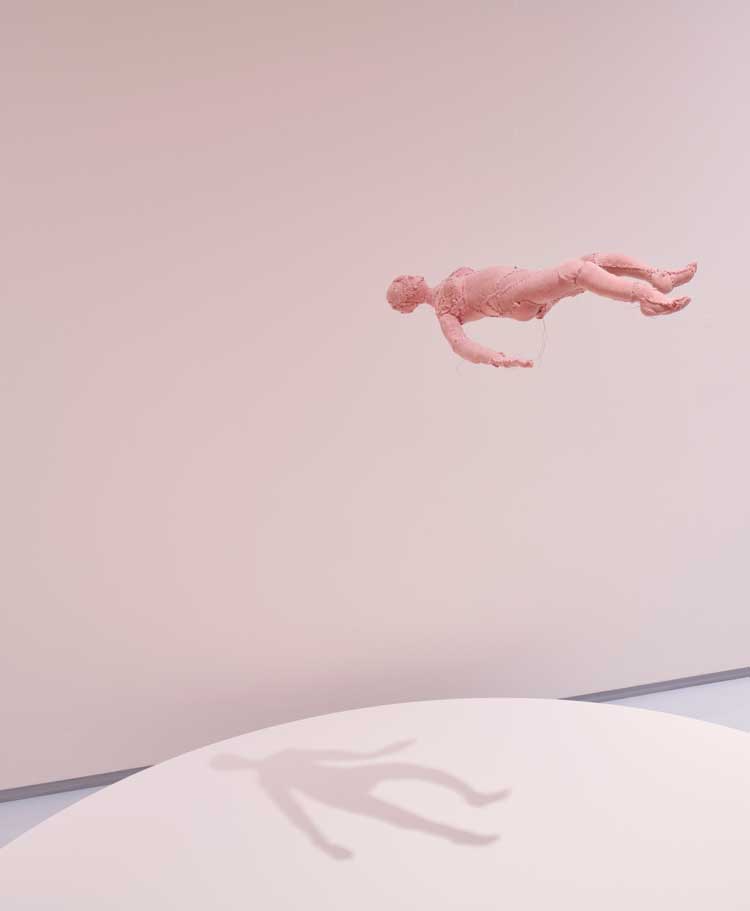
Louise Bourgeois, Arch of Hysteria, 2000. Installation view, Unravel: The Power and Politics of Textiles in Art, Barbican Art Gallery. © Jo Underhill / Barbican Art Gallery.
What can humankind do in the face of the multiple enormous crises faced by the world today? From climate change and the ecological crisis, to political and economic crises to the atrocities of war, what can be done to heal the wounds inflicted by these situations? “Wound and Repair” takes on that huge question in the work of artists who seek to somehow repair the damage. Hong Kong artist Angela Su (b1969) shows three works from her Sewing Together series, made in response to the pro-democracy protests in Hong Kong in 2019. The effects of state violence on mind are body are explored through embroidered images of the suturing of a vulva, and the piercing of an eye and a breast. She embroiders with hair, not thread, adding a further layer of bodily and feminine reference. Arch of Hysteria (2000) by Louise Bourgeois (1911-2010) uses a textile doll or model to convey a psychic experience of pain.
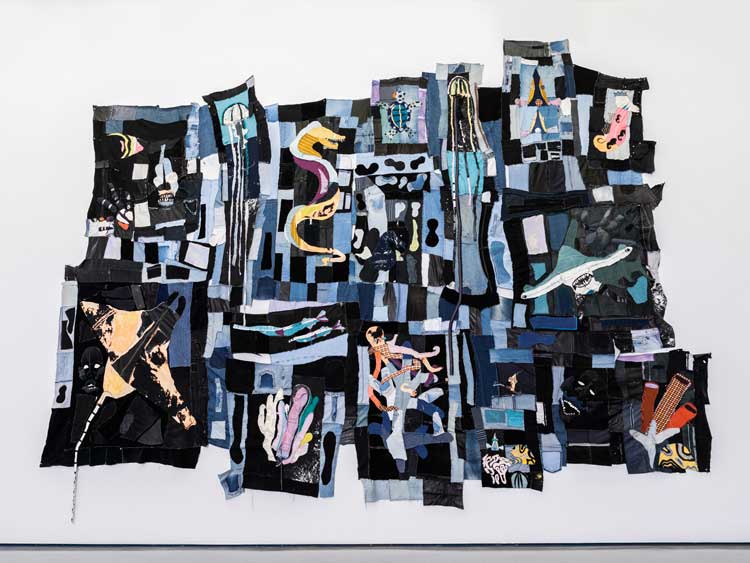
Tau Lewis, The Coral Reef Preservation Society, 2019. © Tau Lewis, courtesy the artist and Night Gallery, Los Angeles.
“Ancestral Threads” is the final and largest section of the exhibition and includes a wide range of artists who explore the layered histories of textiles to tell stories of empire, trade, extraction, enslavement and much more. Looking to their own ancestors, or those of other communities, for inspiration, these artists produce widely different works in response to those histories, but always in textiles of one sort or another. Canadian artist Tau Lewis (b1993) uses recycled fabrics and seashells in The Coral Reef Preservation Society (2019), partly in homage to enslaved people who lost their lives in the Middle Passage, a stage of the Atlantic slave trade. Quipu Austral (2012), a monumental work by the Chilean artist Cecilia Vicuña (b1948) comprising lengths of unspun wool and sound, was made as a “prayer for the union of the world”.
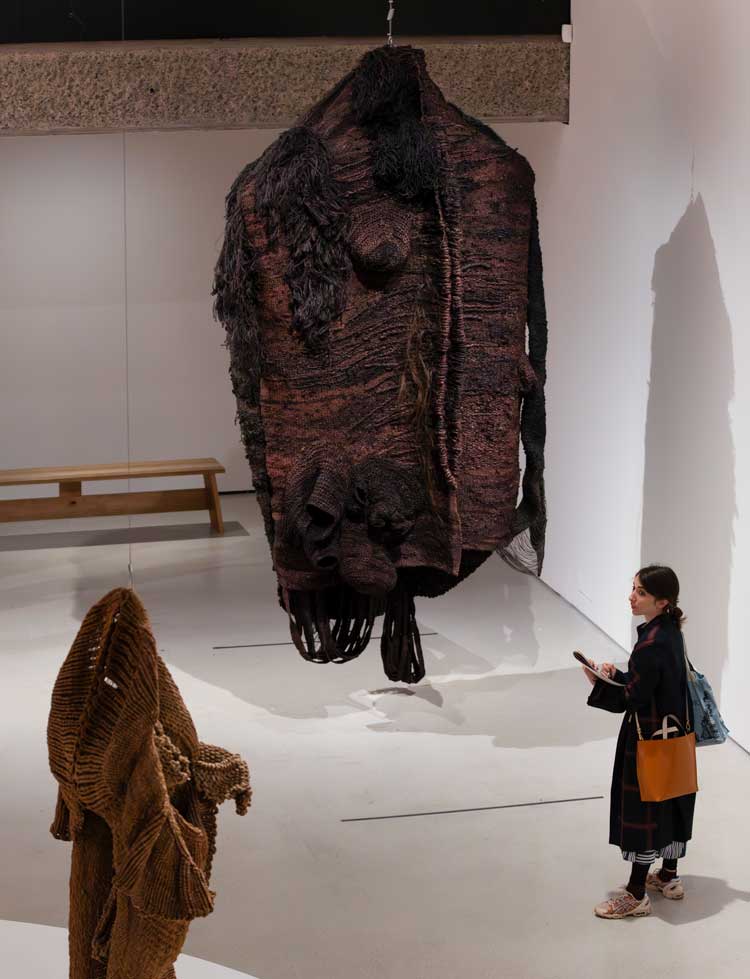
Centre: Magdalena Abakanowicz, Vêtement Noir (Black Garment), 1968. Installation view, Unravel: The Power and Politics of Textiles in Art, Barbican Art Gallery. © Jemima Yong / Barbican Art Gallery.
The fibrous structures of works by Magdalena Abakanowicz (1930-2017) create sculptural environments that nonetheless embrace the vernacular traditions of textiles. Also embracing the expressive potential of natural fibres are three earthy bodies of dyed hemp by the Indian artist Mrinalini Mukherjee (1949-2015). Twisting and knotting ropes found in local markets, Mukherjee created forms or beings in line with her vision of “sculpture as a kind of organic unfolding”. From hemp and sisal to cotton and silk, from the personal to the community, from the injustices of the world to the power and politics of textiles in art, it is a potent medium. Individually, these artists are formidable tellers of stories that need to be told, retold and remembered. Collectively, in this exhibition, it is a reminder of what can be done and how resistance can sometimes unravel in the most unlikely of ways.